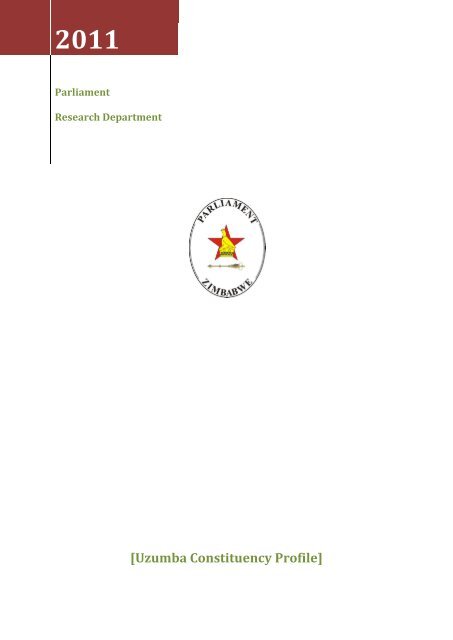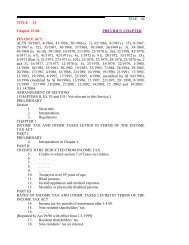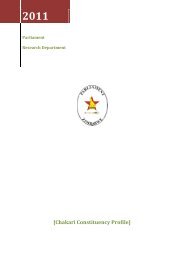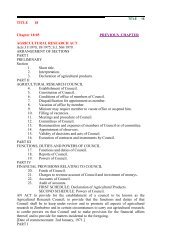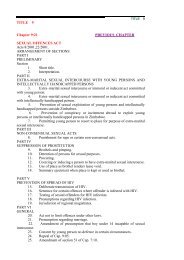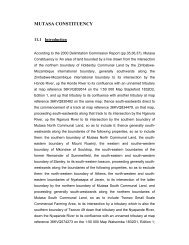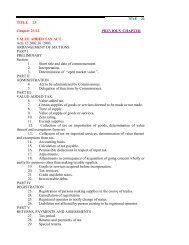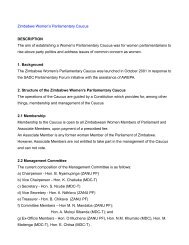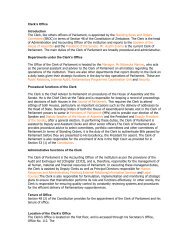Uzumba Constituency Profile - Zimbabwe Parliament
Uzumba Constituency Profile - Zimbabwe Parliament
Uzumba Constituency Profile - Zimbabwe Parliament
You also want an ePaper? Increase the reach of your titles
YUMPU automatically turns print PDFs into web optimized ePapers that Google loves.
2011<br />
<strong>Parliament</strong><br />
Research Department<br />
[<strong>Uzumba</strong> <strong>Constituency</strong> <strong>Profile</strong>]
Table of Contents<br />
1.0 Introduction .................................................................................................................................................................. 3<br />
2.0 Population ...................................................................................................................................................................... 3<br />
3.0 Education........................................................................................................................................................................ 3<br />
3.1 Primary Education ................................................................................................................................................. 3<br />
3.2 Secondary Education ............................................................................................................................................ 5<br />
4.0 Health ............................................................................................................................................................................... 6<br />
5.0 Animal Health ............................................................................................................................................................... 6<br />
5.0 Local Government ....................................................................................................................................................... 7<br />
6.0 Conclusion ...................................................................................................................................................................... 8<br />
7.0 Recommendations ...................................................................................................................................................... 8<br />
Bibliography ................................................................................................................................................................................ 9<br />
List of Figures<br />
Figure 1: Cattle Distribution by Ward ................................................................................................................................... 7<br />
List of Table<br />
Table 1: Primary School Statistics ........................................................................................................................................... 4<br />
Table 2: Secondary School Statistics ...................................................................................................................................... 5<br />
Table 3: Health Facilities in the Constituencies ................................................................................................................. 6<br />
Table 4: Councilors in the <strong>Constituency</strong> ............................................................................................................................... 7<br />
<strong>Uzumba</strong> <strong>Constituency</strong> <strong>Profile</strong> Page 2
1.0 Introduction<br />
<strong>Uzumba</strong> <strong>Constituency</strong> comprises of well-known areas of Nakiwa, <strong>Uzumba</strong>, Muswe, Nyadiri, and<br />
Karimbika. This is a new constituency hived off from the old <strong>Uzumba</strong>-Maramba-Pfungwe<br />
constituency. It is a communal area populated by poor peasant farmers who depend on subsistence<br />
farming. It is one of the most remote parts of the country and has seen very limited development.<br />
(<strong>Zimbabwe</strong> Election Support Network, 2008)<br />
2.0 Population<br />
This constituency has a population of 57 213 people, giving a constituency average of 7 152 people.<br />
There are more females (29 944) than males (27 269) in <strong>Uzumba</strong> constituency. The population is<br />
housed in about 12 369 house-holds with an average house hold size of 4 people. All wards have a<br />
population above 3 000 with the distribution skewed in favour of females. Figure 1 below shows the<br />
distribution pattern of the population across all wards.<br />
3.0 Education<br />
3.1 Primary Education<br />
A total of 23 Primary schools are located within the <strong>Uzumba</strong> constituency, enrolling a total of 14<br />
860 pupils. The constituency enrols less girls (7 337) than boys (7 523) in primary schools and the<br />
same trend is true at secondary level. There are 379 teachers providing primary education, giving a<br />
pupil to teacher ratio of 39:1. All the primary schools are day schools, administered by the Rural<br />
District Council, with 12 of them offering hot seating. The details of primary school enrolment are<br />
detailed in the table below.<br />
<strong>Uzumba</strong> <strong>Constituency</strong> <strong>Profile</strong> Page 3
Ward Number<br />
Date Est.<br />
Boys<br />
Girls<br />
Total<br />
Enrolment<br />
Male<br />
Teachers<br />
Female<br />
Teachers<br />
Total Teachers<br />
Pupil/Teacher<br />
Ratio<br />
Table 1: Primary School Statistics<br />
School Name<br />
Chimhodzi 8 1969 231 249 480 8 4 12 40<br />
Chipfunde 8 1945 387 381 768 15 4 19 40<br />
Marowe 8 1969 248 214 462 6 6 12 39<br />
Chikuhwa 9 1927 549 551 1100 13 15 28 39<br />
Mashambanhaka 9 1945 618 583 1201 14 16 30 40<br />
Chidodo 10 1934 443 473 916 12 11 23 40<br />
Gadaga 11 1996 156 145 301 4 4 8 38<br />
Rudawiro 11 1958 446 425 871 11 11 22 40<br />
Mugabe 12 1923 332 373 705 14 4 18 39<br />
Mupaya 12 1995 175 171 346 4 5 9 38<br />
Musanhi 12 1922 308 293 601 5 10 15 40<br />
Nyamhare 12 1974 212 181 393 3 7 10 39<br />
Manyika 13 1925 439 423 862 15 7 22 39<br />
Matsenga 13 1940 319 312 631 12 4 16 39<br />
Rukariro 13 1945 378 383 761 12 7 19 40<br />
Kaseke 14 1923 189 203 392 8 2 10 39<br />
Machekera 14 1923 282 229 511 7 6 13 39<br />
Magunje 14 1955 436 405 841 10 12 22 38<br />
Mayema 14 1972 230 234 464 5 7 12 39<br />
Morris 14 1949 302 284 586 9 6 15 39<br />
Mutize 14 2010 75 70 145 3 1 4 36<br />
Chitimbe 15 1933 436 425 861 8 15 23 37<br />
Marembera 15 1951 332 330 662 13 4 17 39<br />
Total 7523 7337 14860 211 168 379 39<br />
<strong>Uzumba</strong> <strong>Constituency</strong> <strong>Profile</strong> Page 4
Ward<br />
Date Est.<br />
Boys<br />
Girls<br />
Grand<br />
Total<br />
Male<br />
Teachers<br />
Female<br />
Teachers<br />
Total<br />
teachers<br />
Pupil/teac<br />
her ratio<br />
3.2 Secondary Education<br />
There are 13 secondary schools in the <strong>Uzumba</strong> constituency enrolling a total of 4 851 pupils. There<br />
are about 205 teachers providing secondary education, giving a pupil to teacher ratio of 24:1.<br />
<strong>Uzumba</strong> is the only boarding school in the constituency and all the schools are under the<br />
administration of the Rural District Council. The details of secondary school enrolment are as given<br />
in the table below.<br />
Table 2: Secondary School Statistics<br />
Name<br />
Chipfunde 8 1987 116 96 212 8 2 10 21<br />
Chikuhwa 9 1981 290 262 552 12 9 21 26<br />
Chidodo 10 1988 157 137 294 9 3 12 25<br />
Rudawiro 11 1985 257 188 445 13 4 17 26<br />
Mugabe 12 1981 253 254 507 12 5 17 30<br />
Musanhi (UMP) 12 1987 158 112 270 8 4 12 23<br />
Nyamhara 12 2006 67 44 111 3 4 7 16<br />
Rukariro 13 2009 70 45 115 3 3 6 19<br />
<strong>Uzumba</strong> 13 1974 240 307 547 20 7 27 20<br />
Magunje 14 1981 342 252 594 20 6 26 23<br />
Morris 14 1982 231 213 444 10 6 16 28<br />
Chitimbe 15 1984 260 232 492 14 8 22 22<br />
Marembera 15 1984 137 131 268 8 4 12 22<br />
Total 2578 2273 4851 140 65 205 24<br />
<strong>Uzumba</strong> <strong>Constituency</strong> <strong>Profile</strong> Page 5
Ward<br />
Year Est.<br />
Status<br />
Nurses<br />
Maternity<br />
General<br />
Access<br />
Road<br />
Fire<br />
Protection<br />
Perimeter<br />
Fencing<br />
Power<br />
Supply<br />
4.0 Health<br />
There are 9 clinics in <strong>Uzumba</strong> constituency. Among these, Chipfunde is the only clinic that has not<br />
been connected to ZESA grid. Communication and vehicular services are the major challenges in<br />
all these institutions. Only 18 nurses provide health service in the constituency and doctors hardly<br />
attend patients. Further details on health institutions are as highlighted in the table below.<br />
Table 3: Health Facilities in the Constituencies<br />
Name<br />
Authority<br />
8 Chipfunde 80s Clinic 2 2 2 RDC Yes Yes Good No<br />
9 Chikuhwa 80s Clinic 2 2 2 RDC Yes Yes Good Yes<br />
9 Mashambanhaka<br />
80s Clinic 2 2 2 Mission<br />
United<br />
Methodist<br />
Yes Yes Good Yes<br />
11 Karimbika 80s Clinic 2 2 2 Government Yes Yes Good Yes<br />
12 Muskwe 1997 Clinic 2 2 2 RDC Yes Yes Good Yes<br />
13 Manyika 80s Clinic 2 2 2 RDC Yes Yes Good Yes<br />
14 Nhakiwa 80s Clinic 2 2 2 RDC Yes Yes Good Yes<br />
15 Chitimbe 80s Clinic 2 2 2 RDC Yes Yes Good Yes<br />
15 Marembera 80s Clinic 2 2 2 Government Yes Yes Good Yes<br />
5.0 Animal Health<br />
There are 28 090 cattle in a constituency with a capacity of 250 000 cattle. The constituency has 15<br />
dip-tanks and four Animal Health Management Centres. Ward 9 and 10 has got more than 4000<br />
cattle each whilst ward 11 and 12 has at most 1 500 each. Other wards has got cattle averaging<br />
between 1 500 and 4000.<br />
<strong>Uzumba</strong> <strong>Constituency</strong> <strong>Profile</strong> Page 6
Figure 1: Cattle Distribution by Ward<br />
5.0 Local Government<br />
The constituency consists of five male councilors and two female councilors at local government<br />
level.<br />
Table 4: Councilors in the <strong>Constituency</strong><br />
Councilor Ward Gender<br />
Munhenga 8 F<br />
Matanhire 9 F<br />
Manguwo 10 M<br />
Gotora 11 M<br />
OD 12 M<br />
Gumbure 13 M<br />
Nyamhandu 14 M<br />
<strong>Uzumba</strong> <strong>Constituency</strong> <strong>Profile</strong> Page 7
6.0 Conclusion<br />
<strong>Uzumba</strong> is a remote communal constituency dominated by poor peasant farmers who depend on<br />
subsistence farming as a source of livelihood. Enrolment at both primary and secondary schools is<br />
skewed in favour of boys. There are a number of clinics that are well connected to power supply<br />
though they face challenges in access to communication as well as vehicular services.<br />
7.0 Recommendations<br />
Provide communication and vehicular services to clinics<br />
Incentives to promote girl child education.<br />
More classrooms at schools to deal with the problem of hot seating.<br />
Promote communities to venture into cattle ranching<br />
<strong>Uzumba</strong> <strong>Constituency</strong> <strong>Profile</strong> Page 8
Bibliography<br />
1. Central Statistical Office (CSO), 2002. Census 2002 Provincial <strong>Profile</strong>: Mashonaland<br />
East, Government of <strong>Zimbabwe</strong>, Harare<br />
2. Government of <strong>Zimbabwe</strong>, 2006. <strong>Zimbabwe</strong> 2003 Poverty Assessment Study Survey<br />
Summary (PASS) Report, Ministry of Public Service , Labour and Social Welfare, July<br />
2006, Harare<br />
3. Government of <strong>Zimbabwe</strong>, UNDP, 2010. 2010 Millennium Development Goals Status<br />
Report, Ministry of Labour and Social Services, UNDP, Harare<br />
4. <strong>Zimbabwe</strong> Election Support Network (ZESN), 2008, A profile of Constituencies:<br />
Understanding Elections in <strong>Zimbabwe</strong>, ZESN, Harare.<br />
5. <strong>Zimbabwe</strong> Electoral Commission (ZEC), 2008. The report on the Delimitation Exercise for<br />
the 2008 Harmonised Elections, Government of <strong>Zimbabwe</strong>, Harare.<br />
6. <strong>Zimbabwe</strong> Vulnerability Assessment Committee (ZimVac), 2009 ZimVac Rural Household<br />
Livelihoods Survey Report No.11, October 2009, Harare<br />
Contact Information<br />
For Enquiries, views and comments write to:<br />
The Clerk of <strong>Parliament</strong><br />
Attn: Informatics Project Administrator<br />
<strong>Parliament</strong> of <strong>Zimbabwe</strong> Cnr. Kwame Nkurumah and 3 rd Street<br />
P.O. Box CY 298, Causeway,<br />
Harare, <strong>Zimbabwe</strong><br />
Tel: 263-4-700181-8,263-4-252936-49<br />
Fax: 263-4-252935<br />
E-mail: research@parlzim.gov.zw<br />
Website: www.parlzim.gov.zw<br />
<strong>Uzumba</strong> <strong>Constituency</strong> <strong>Profile</strong> Page 9


